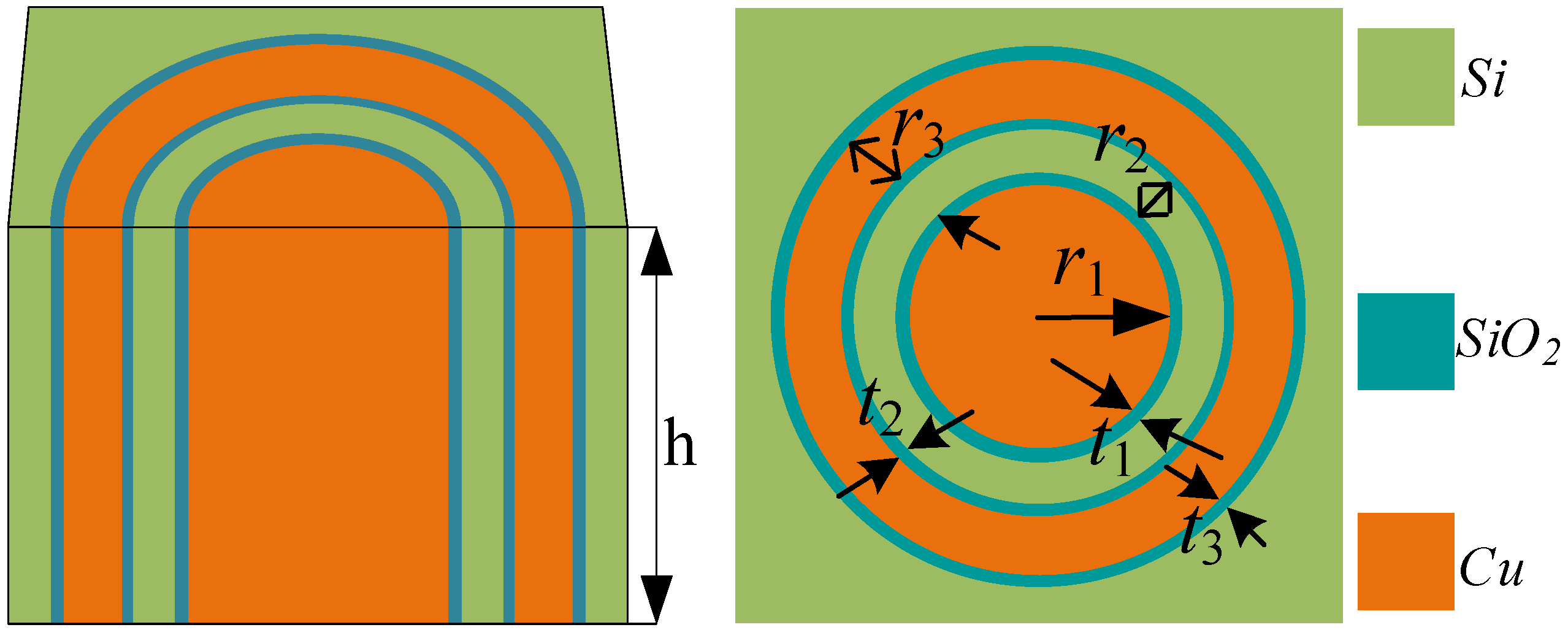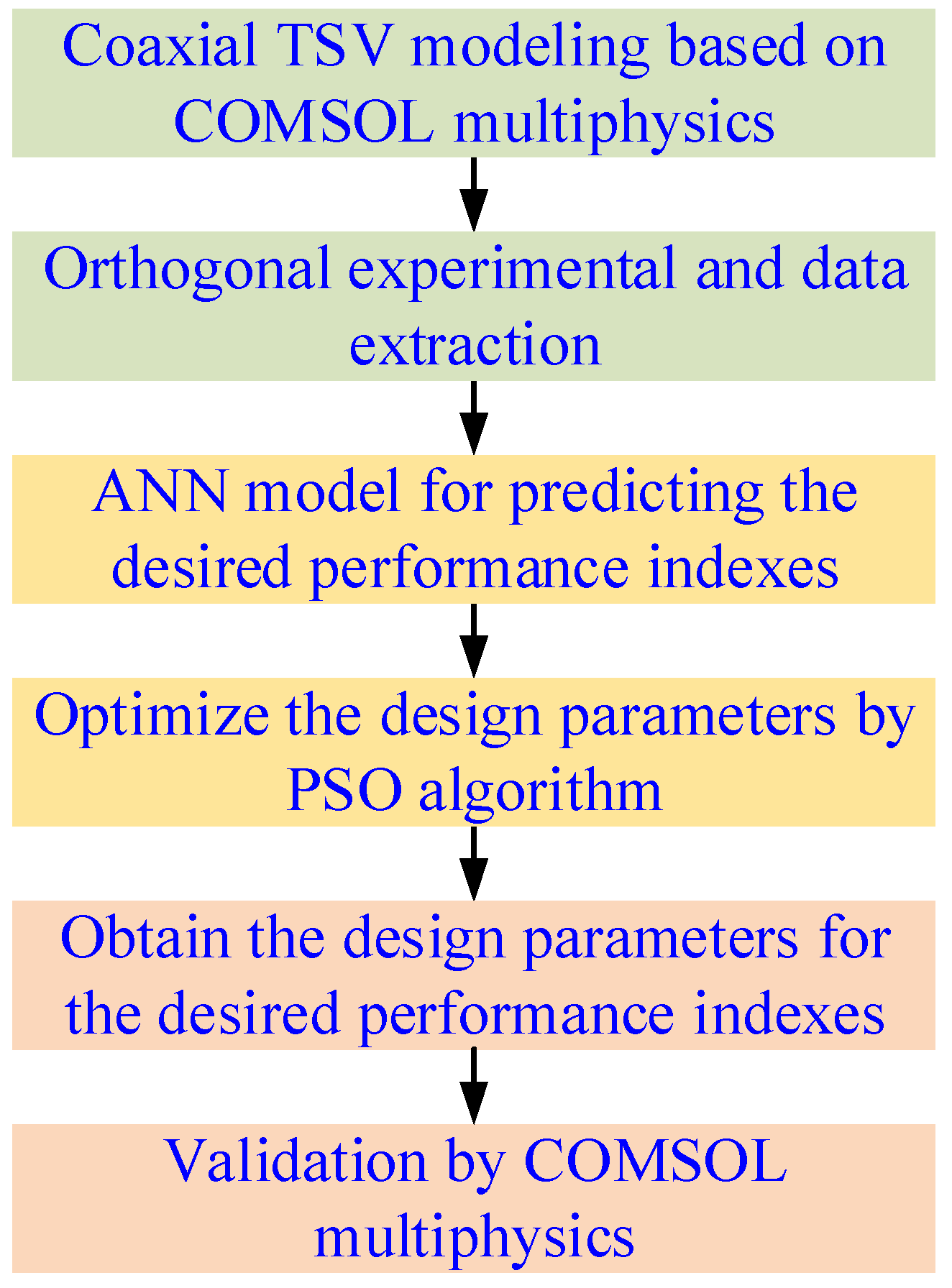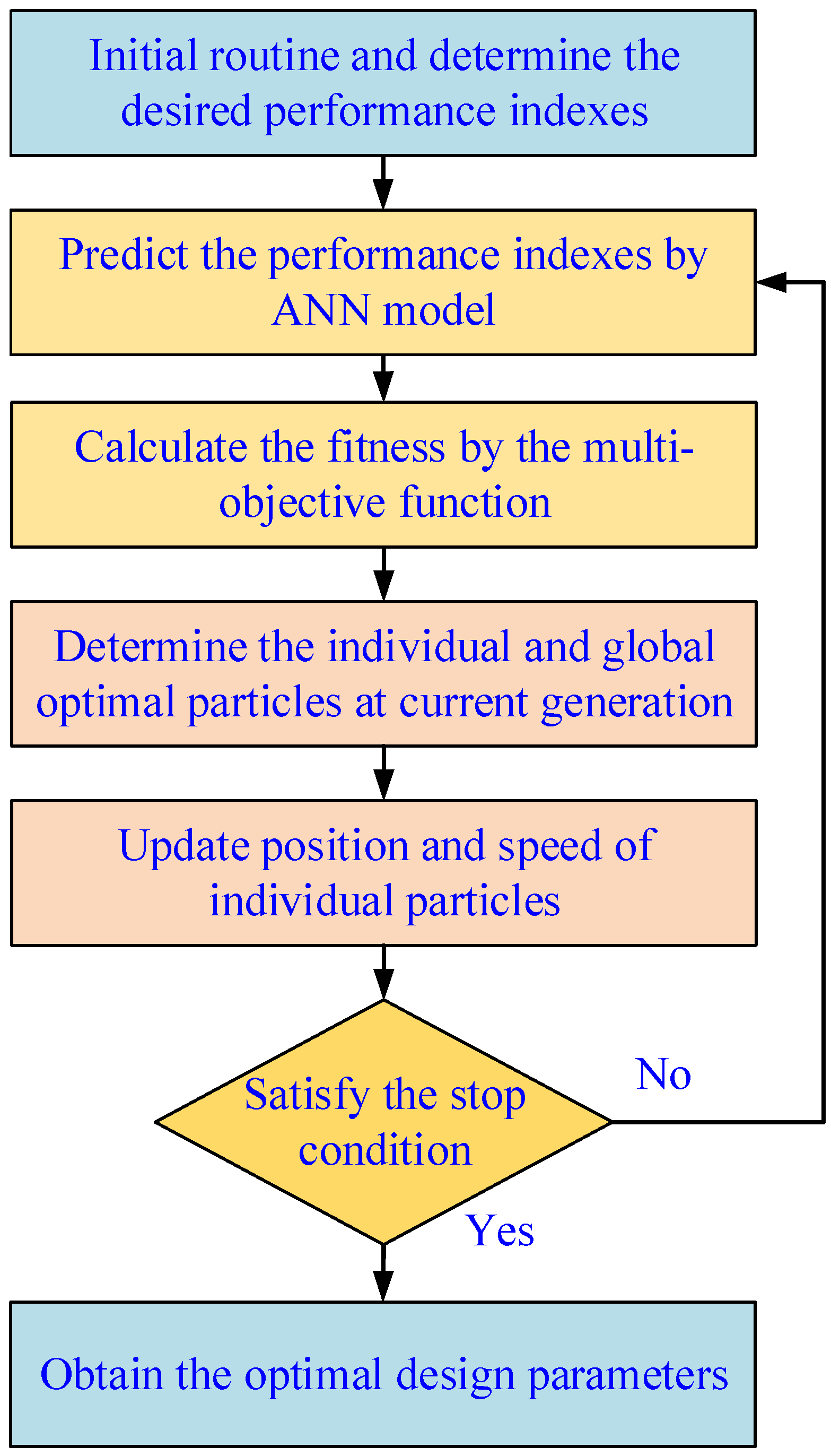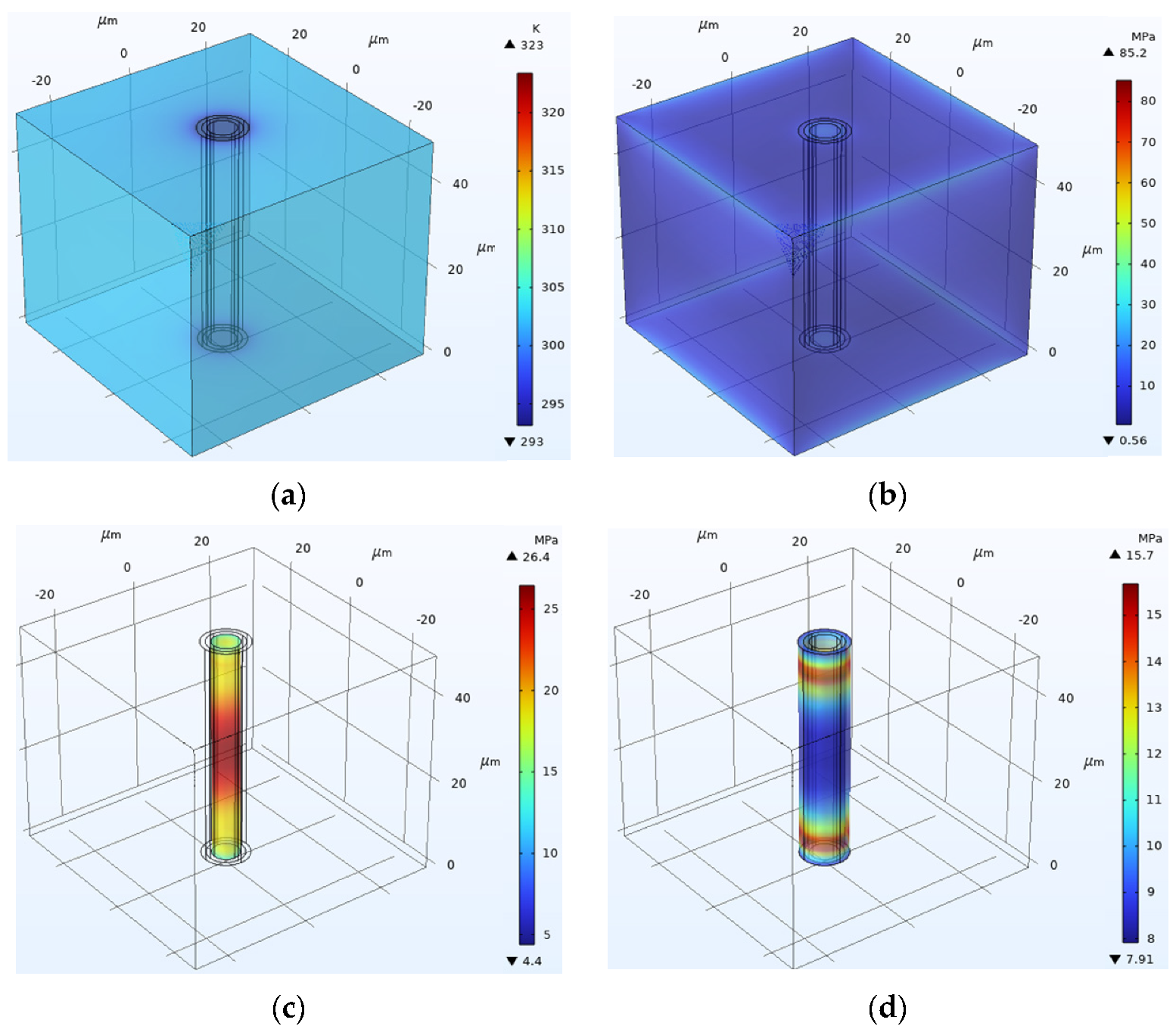Thermal-Stress Coupling Optimization for Coaxial through Silicon Via
Abstract
:1. Introduction
- (1)
- The mapping relationships between design parameters and thermal-stress performance indexes are described by ANN models to increase the efficiency of simulation design.
- (2)
- Based on the PSO algorithm, the thermal-stress coupling optimization method is proposed to control the thermal-stress distribution of coaxial TSV.
2. Finite Element Simulation of Coaxial TSV
2.1. Thermal-Stress Coupling Model
2.2. Finite Element Model of Coaxial TSV
2.3. Simulation Results
3. Thermal-Stress Coupling Optimization of Coaxial TSV
3.1. ANN Models for Performance Indexes
3.2. Multi-Objective Optimization Function
3.3. Optimize Parameters by Particle Swarm Optimization Algorithm
4. Implementation and Discussion
4.1. Implementation
4.2. Comparison and Discussion
5. Conclusions
Author Contributions
Funding
Institutional Review Board Statement
Informed Consent Statement
Data Availability Statement
Conflicts of Interest
References
- Burns, J.A.; Aull, B.F.; Chen, C.K.; Chen, C.L.; Keast, C.L.; Knecht, J.M.; Suntharalingam, V.; Warner, K.; Wyatt, P.W.; Yost, D.R. A wafer-scale 3-D circuit integration technology. IEEE Trans. Electron Dev. 2006, 53, 2507–2516. [Google Scholar] [CrossRef]
- Wang, X.; Yang, Y.; Chen, D.; Li, D. A High-Efficiency Design Method of TSV Array for Thermal Management of 3D Integrated System. Available online: https://ieeexplore.ieee.org/document/9915793 (accessed on 11 October 2022).
- Knickerbocker, J.U.; Patel, C.S.; Andry, P.S.; Tsang, C.K.; Buchwalter, L.P.; Sprogis, E.J.; Gan, H.; Horton, R.R.; Polastre, R.J.; Wright, S.L.; et al. 3-D Silicon Integration and Silicon Packaging Technology Using Silicon Through-Vias. IEEE J. Solid-State Circ. 2006, 41, 1718–1725. [Google Scholar] [CrossRef]
- Shulaker, M.M.; Hills, G.; Park, R.S.; Howe, R.T.; Saraswat, K.; Wong, H.S.; Mitra, S. Three-dimensional integration of nanotechnologies for computing and data storage on a single chip. Nature 2017, 547, 74–78. [Google Scholar] [CrossRef]
- Xu, Z.; Lu, J.Q. Three-Dimensional Coaxial Through-Silicon-Via (TSV) Design. IEEE Electr. Device Lett. 2012, 33, 1441–1443. [Google Scholar] [CrossRef]
- Qian, L.; Qian, K.; He, X.; Chu, Z.; Ye, Y.; Shi, G.; Xia, Y. Through-Silicon Via-Based Capacitor and Its Application in LDO Regulator Design. IEEE Trans. VLSI Syst. 2019, 27, 1947–1951. [Google Scholar] [CrossRef]
- Qu, C.; Ding, R.; Liu, X.; Zhu, Z. Modeling and Optimization of Multiground TSVs for Signals Shield in 3-D ICs. IEEE Trans. Electromagn. Compat. 2017, 59, 461–467. [Google Scholar] [CrossRef]
- Yin, X.; Zhu, Z.; Yang, Y.; Ding, R. Thermo-Mechanical Characterization of Single-Walled Carbon Nanotube (SWCNT)-Based Through-Silicon via (TSV) in (100) Silicon. Nanosci. Nanotechnol. Lett. 2015, 7, 481–485. [Google Scholar] [CrossRef]
- Dong, G.; Shi, T.; Zhao, Y.B.; Yang, Y.T. An analytical model of thermal mechanical stress induced by through silicon via. Chin. Phys. B 2015, 24, 056601. [Google Scholar] [CrossRef]
- Zhao, W.S.; Wang, X.P.; Xu, X.L.; Yin, W.Y. Electrothermal modeling of coaxial through silicon via (TSV) for three-dimensional ICs. In Proceedings of the 2010 IEEE Electrical Design of Advanced Package & Systems Symposium, Singapore, 7–9 December 2010; pp. 1–4. [Google Scholar]
- Zhao, W.S.; Yin, W.Y.; Wang, X.P.; Xu, X.L. Frequency- and Temperature-Dependent Modeling of Coaxial Through-Silicon Vias for 3-D ICs. IEEE Trans. Electron Dev. 2011, 58, 3358–3368. [Google Scholar] [CrossRef]
- Qian, L.; Xia, Y.; He, X.; Qian, K.; Wang, J. Electrical Modeling and Characterization of Silicon-Core Coaxial Through-Silicon Vias in 3-D Integration. IEEE Trans. Compon. Packag. Manuf. Technol. 2018, 8, 1336–1343. [Google Scholar] [CrossRef]
- Dixit, P.; Yaofeng, S.; Miao, J.; Pang, J.H.; Chatterjee, R.; Tummala, R.R. Numerical and Experimental Investigation of Thermomechanical Deformation in High-Aspect-Ratio Electroplated Through-Silicon Vias. J. Electrochem. Soc. 2008, 155, H981. [Google Scholar] [CrossRef]
- Tsai, H.Y.; Kuo, C.W. Thermal Stress and Failure Location Analysis for Through Silicon via in 3D Integration. J. Mech. 2016, 32, 47–53. [Google Scholar] [CrossRef]
- Chen, D.D.; Lin, Y.C.; Wu, F. A design framework for optimizing forming processing parameters based on matrix cellular automaton and neural network-based model predictive control methods. Appl. Math. Model. 2019, 76, 918–937. [Google Scholar] [CrossRef]
- Lin, Y.C.; Chen, D.D.; Chen, M.S.; Chen, X.M.; Li, J. A precise BP neural network-based online model predictive control strategy for die forging hydraulic press machine. Neural Comput. Appl. 2018, 9, 585–596. [Google Scholar] [CrossRef]
- Garud, K.S.; Seo, J.H.; Cho, C.P.; Lee, M.Y. Artificial Neural Network and Adaptive Neuro-Fuzzy Interface System Modelling to Predict Thermal Performances of Thermoelectric Generator for Waste Heat Recovery. Symmetry 2020, 12, 259. [Google Scholar] [CrossRef] [Green Version]
- Abuzneid, M.A.; Mahmood, A. Enhanced Human Face Recognition Using LBPH Descriptor, Multi-KNN, and Back-Propagation Neural Network. IEEE Access 2018, 6, 20641–20651. [Google Scholar] [CrossRef]
- Wei, J. Application of Hybrid Back Propagation Neural Network in Image Compression. In Proceedings of the 2015 8th International Conference on Intelligent Computation Technology and Automation (ICICTA) 2015, Nanchang, China, 14–15 June 2015; pp. 209–212. [Google Scholar]
- Bogiatzis, A.; Papadopoulos, B. Papadopoulos. Global Image Thresholding Adaptive Neuro-Fuzzy Inference System Trained with Fuzzy Inclusion and Entropy Measures. Symmetry 2019, 11, 286. [Google Scholar] [CrossRef] [Green Version]
- Xu, L.; Zhang, Z.; Yao, Y.; Yu, Z. Improved Particle Swarm Optimization-Based BP Neural Networks for Aero-Optical Imaging Deviation Prediction. IEEE Access 2022, 10, 26769–26777. [Google Scholar] [CrossRef]
- Lu, Y.; Yan, D.; Zhang, J.; Levy, D. Direct back propagation neural dynamic programming-based particle swarm optimization. Connect. Sci. 2014, 26, 367–368. [Google Scholar] [CrossRef]
- Ullah, I.; Fayaz, M.; Kim, D. Improving Accuracy of the Kalman Filter Algorithm in Dynamic Conditions Using ANN-Based Learning Module. Symmetry 2019, 11, 94. [Google Scholar] [CrossRef]
- Chen, D.D.; Lin, Y.C. A particle swarm optimization-based multi-level processing parameters optimization method for controlling microstructures of an aged superalloy during isothermal forging. Met. Mater. Int. 2019, 25, 1246–1257. [Google Scholar] [CrossRef]
- Chen, D.D.; Lin, Y.C.; Chen, X.M. A strategy to control microstructures of a Ni-based superalloy during hot forging based on particle swarm optimization algorithm. Adv. Manuf. 2019, 7, 238–247. [Google Scholar] [CrossRef]
- Chen, D.; Zhao, J.; Fei, C.; Li, D.; Zhu, Y.; Li, Z.; Guo, R.; Lou, L.; Feng, W.; Yang, Y. Particle swarm optimization algorithm-based design method for ultrasonic transducers. Micromachines 2020, 11, 715. [Google Scholar] [CrossRef] [PubMed]
- Li, D.; Wang, X.; Chen, D.; Zhang, Q.; Yang, Y. A precise ultra-wideband ranging method using pre-corrected strategy and particle swarm optimization algorithm. Measurement 2022, 194, 110966. [Google Scholar] [CrossRef]
- Yang, Y.; Wang, X.; Li, D.; Chen, D.; Zhang, Q. An Improved Indoor 3-D Ultrawideband Positioning Method by Particle Swarm Optimization Algorithm. IEEE Trans. Instrum. Meas. 2022, 71, 1–11. [Google Scholar] [CrossRef]
- Fritz, T.; Mokwa, W.; Schnakenberg, U. Material characterisation of electroplated nickel structures for microsystem technology. Electrochim. Acta 2001, 47, 55–60. [Google Scholar] [CrossRef]
- Read, D.T.; Cheng, Y.W.; Geiss, R. Morphology, microstructure, and mechanical properties of a copper electrodeposit. Microelectron. Eng. 2004, 75, 63–70. [Google Scholar] [CrossRef]
- Al Farisi, M.S.; Tsukamoto, T.; Tanaka, S. Tailoring material properties of electrochemically deposited Al film from chloroaluminate ionic liquid for microsystem technology using pulsed deposition. Sens. Actuators A Phys. 2020, 316, 112384. [Google Scholar] [CrossRef]
- Wang, F.; Zhu, Z.; Yang, Y.; Liu, X.; Ding, R. Thermo-mechanical performance of Cu and SiO2 filled coaxial through-silicon-via (TSV). IEICE Electron. Express 2013, 10, 20130894. [Google Scholar] [CrossRef]







| Materials | Cu | SiO2 | Si |
|---|---|---|---|
| Thermal conductivity (W/(m*K)) | 401 | 1.4 | 130 |
| Thermal expansivity (ppm/K) | 17 | 0.5 | 2.3 |
| Young modulus (GPa) | 110 | 71 | 130 |
| Poisson ratio | 0.35 | 0.16 | 0.28 |
| Parameters of the multi-objective optimization function | Desired performance indexes | |
| Weight coefficients | ||
| Parameters of PSO algorithm | Constant parameters | |
| Maximum generation | ||
| Population size | ||
| Range of inertia weight | ||
| Range of particle position | ||
| Range of particle velocity |
| Indexes | Case | ||
|---|---|---|---|
| A | B | ||
| Desired | PT (K) | 325 | 320 |
| PS1 (MPa) | 85 | 80 | |
| PS2 (MPa) | 25 | 30 | |
| PS3 (MPa) | 16 | 15 | |
| Optimized | PT (K) | 323.42 | 321.94 |
| PS1 (MPa) | 85.71 | 81.08 | |
| PS2 (MPa) | 26.61 | 29.74 | |
| PS3 (MPa) | 16.33 | 19.47 | |
| Simulated | PT (K) | 323.38 | 321.58 |
| PS1 (MPa) | 85.28 | 80.51 | |
| PS2 (MPa) | 26.46 | 24.96 | |
| PS3 (MPa) | 16.41 | 15.6 | |
Disclaimer/Publisher’s Note: The statements, opinions and data contained in all publications are solely those of the individual author(s) and contributor(s) and not of MDPI and/or the editor(s). MDPI and/or the editor(s) disclaim responsibility for any injury to people or property resulting from any ideas, methods, instructions or products referred to in the content. |
© 2023 by the authors. Licensee MDPI, Basel, Switzerland. This article is an open access article distributed under the terms and conditions of the Creative Commons Attribution (CC BY) license (https://creativecommons.org/licenses/by/4.0/).
Share and Cite
Chen, D.; Yang, Y.; Wang, X.; Li, D.; Liang, Y.; Xu, C. Thermal-Stress Coupling Optimization for Coaxial through Silicon Via. Symmetry 2023, 15, 264. https://doi.org/10.3390/sym15020264
Chen D, Yang Y, Wang X, Li D, Liang Y, Xu C. Thermal-Stress Coupling Optimization for Coaxial through Silicon Via. Symmetry. 2023; 15(2):264. https://doi.org/10.3390/sym15020264
Chicago/Turabian StyleChen, Dongdong, Yintang Yang, Xianglong Wang, Di Li, Yi Liang, and Changqing Xu. 2023. "Thermal-Stress Coupling Optimization for Coaxial through Silicon Via" Symmetry 15, no. 2: 264. https://doi.org/10.3390/sym15020264






